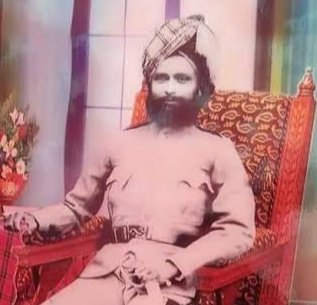• Traditional Origins
The Kakan Rajputs are Suryavanshi Kshatriyas who descend from Bharata , the younger brother of Lord Rāma.
Bharat ji was the son of Kaikeyī , one of the 3 chief queens of Raja Daśaratha of Ayodhyā. (2/20)
The Kakan Rajputs are Suryavanshi Kshatriyas who descend from Bharata , the younger brother of Lord Rāma.
Bharat ji was the son of Kaikeyī , one of the 3 chief queens of Raja Daśaratha of Ayodhyā. (2/20)
Bharata was married to Māṇḍavī , a princess of Mithilā.
They had a son named Pushkal.
Pushkal was sent to Kekaya , his grandmother's ( Kaikeyi's ) homeland to fight with the neighbouring Gandhāra Kingdom. (3/20)
They had a son named Pushkal.
Pushkal was sent to Kekaya , his grandmother's ( Kaikeyi's ) homeland to fight with the neighbouring Gandhāra Kingdom. (3/20)
Kekaya roughly refers to present day Jhelum district of Modern day Pak. Punjab. Some Kakans still use "Kaikaya" as a surname which shows their Descent from queen Kaikeyī.
Pushkal defeated the Gandharas and established the city "Pushkalavati". (4/20)
Pushkal defeated the Gandharas and established the city "Pushkalavati". (4/20)

The Descendants of Pushkal continued to live in Pushkalavati ( Gandhāra ) and Kekaya for thousands of years before they started to migrate. (5/20)
From Pushkalavati , they migrated southward to Rajasthan and then to Gujarat where they served the Solanki ( Chaulukya ) Rajputs.
From there they migrated to the Sapta Konkan region. (6/20)
From there they migrated to the Sapta Konkan region. (6/20)
The Mūla Rishi gotra of the Kākans was Kashyap but after the Bhargava Brahmins of Konkan became their priests , they got Bhargav as their Rishi gotra.
Some Kākans have Bharadwaj gotra as well. ( Rishi gotra in Kshatriyas can change ). (7/20)
Some Kākans have Bharadwaj gotra as well. ( Rishi gotra in Kshatriyas can change ). (7/20)

From the Sapta Konkan region , two branches split -
- One went to Māhiṣmatī and started to serve the Haihayavanshi Rajputs.
- After some time another branch went to Delhi and first served the Chauhan Rajputs and then the Delhi sultanate. (8/20)
- One went to Māhiṣmatī and started to serve the Haihayavanshi Rajputs.
- After some time another branch went to Delhi and first served the Chauhan Rajputs and then the Delhi sultanate. (8/20)
A source that shows us that Kakans were present in Delhi is from Alha Khand , where while listing various Rajput clans - the Kakans are named as "Kākan Dilli ke"
1st photo is the translation , the 2nd is the original text. (9/20)

1st photo is the translation , the 2nd is the original text. (9/20)


Now the migration to gangetic plains starts. the Māhiṣmatī branch, goes to Tripuri and then a Junior house of Haihayas was founded in Ratnapura.
From here, under the Haihaya Rajput Chandrajyoti Dev, the Kakans migrated first to Saran and then finally to Ballia. (10/20)
From here, under the Haihaya Rajput Chandrajyoti Dev, the Kakans migrated first to Saran and then finally to Ballia. (10/20)

In Ballia , the Haihaya Rajputs established the Haldi Royal house and Kakan Rajputs established settlements and Zamindaris. (11/20)
In this specific migration , the Kakans were led by Raghu Kunwar , the commander of Chandrajyoti Dev's Army.
Raghu Kunwar had 13 brothers , all of whom were given the Upādhi of Kunwar by the Haihayas of Haldi. (12/20)
Raghu Kunwar had 13 brothers , all of whom were given the Upādhi of Kunwar by the Haihayas of Haldi. (12/20)
The Kakan Rajputs of Ballia Descend from these Kakans who came with the Haihaya Rajputs from Ratnapura. (13/20)
Now the migration of the Delhi Branch:
On imperial command , the Branch settled in Delhi moved east under Baba Laukamdev. They reached Aldemau-Saurada in the Mau district and Raja Laukamdev ji made it his capital.
Map of Aldemau-Saurada under the Kakans :
(14/20)
On imperial command , the Branch settled in Delhi moved east under Baba Laukamdev. They reached Aldemau-Saurada in the Mau district and Raja Laukamdev ji made it his capital.
Map of Aldemau-Saurada under the Kakans :
(14/20)

Laukamdev ji also defeated the Chandravanshi Rajput king named Chirkut Singh and established Kakan influence in the Azamgarh and Mau districts. (15/20)
Baba Laukamdev had two sons - Arjun Dev and Ratan Dev. Raja Arjun Dev being the elder son ascended the throne and increased Kakan influence in the Azamgarh-Mau region.
A map of the Mau district region where Kakan rule expanded :
(16/20)
A map of the Mau district region where Kakan rule expanded :
(16/20)

Raja Ratan Dev , after marrying a Chandel Rajput princess of Ghazipur , established the Khadva Kshetra in the Ghazipur district and the influence of the Kakan Rajputs started increasing in this district as well.
A map of Khadva Kshetra :
(17/20)
A map of Khadva Kshetra :
(17/20)

So , The Kakans of Azamgarh , Mau and Ghazipur are descended from Raja Laukamdev through his two sons - Raja Arjun Dev and Raja Ratan Dev. (18/20)
The Kakan Rajputs of Saran , Samastipur and Muzaffarpur regions of Bihar have branched out from both the Azamgarh - Mau - Ghazipur and Ballia branches. 

This is what Thakur Uday Narayan Singhji wrote about the Kakan Rajputs in his Kshatriya Vamshvali :
(20/20)
(20/20)

@threadreaderapp unroll
• • •
Missing some Tweet in this thread? You can try to
force a refresh














